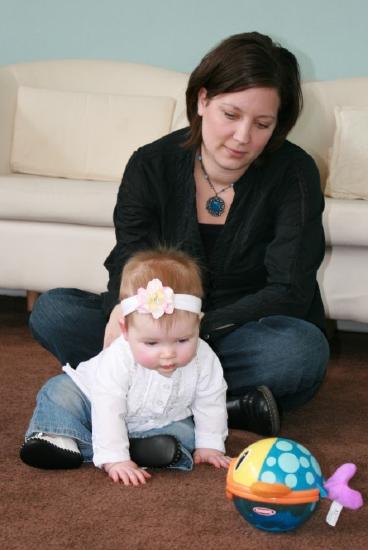17.3: Practices Supporting Social-Emotional Development
- Page ID
- 141503
Supporting Social-Emotional Development
During the first 4 months of life, babies begin to engage with the world and its people (Advances in Applied Developmental Psychology 1995). Infants' motivation to seek relationships and build knowledge drives them to move their bodies, focus their attention, and send and receive signals (the basis for development and learning in all domains). Their active engagement with the social and physical world works hand in hand with the care they receive from adults, especially when the adults are responsive to them.[1]
Noticing and responding during this rapid developmental period can be challenging for caregivers. To be in tune with young infants, adults need to know when an infant wants a social response and when an infant is making a discovery through individual exploration and observation.[1]

Early care centers must establish policies and practices to support responsive caregiving, so infants learn to regulate their emotions and to develop a sense of predictability, safety, and responsiveness in their social environments. The importance is so great that research experts have broadly concluded that, in the early years, "nurturing, stable and consistent relationships are the social-emotional development key to healthy growth, development, and learning" (National Research Council and Institute of Medicine 2000, p. 412). High-quality relationships increase the likelihood of positive outcomes for young children. Professionals working in childcare settings can support the social–emotional development of infants and toddlers in various ways: interacting directly with young children, communicating with families, arranging the physical space in the care environment, and planning and implementing curriculum.
Emotions drive early learning. Infants and toddlers are active, curious learners who experience pleasure when receiving a positive response from a nurturing adult or when making a discovery. This pleasure motivates children to continue engaging in positive interactions, exploring, and learning. The emotional responses of infants and toddlers communicate their interests and needs. It is important for caregivers to read infant and toddler cues to pick up on learning interests and meet needs. By reading emotional cues, caregivers determine whether to engage in interaction with a child or wait quietly to see what the child will do next. Emotional cues let teachers know if children are ready for more interaction, want more complexity added to their play, or are tired and need quiet time. Responsiveness to a child's emotional cues strengthens the teacher–child relationship and creates new possibilities for the child's learning in the social–emotional domain and in all other developmental domains.[2]
Children are learning from their interactions with caregivers every moment of every day. Through relationships with children, educators provide an environment in which children can learn and thrive in the company of a trusted adult. Caregiving routines offer essential social experiences and support for infants and toddlers because they happen regularly and consistently. By experiencing and participating in these routines, children learn what it means to be nurtured in a caring way. Children also learn to engage in reciprocal, responsive interactions in supportive relationships with adults.

Caregivers should understand how important adults are for modeling, demonstrating affection and responsiveness to the needs of young children, and teaching interaction attitudes and skills.[1]
- Consider what is culturally appropriate for the child and include non-verbal gestures (such as a warm smile, a wave hello, a reassuring touch, and eye contact) that convey "you are welcome here."
- Notice and acknowledge prosocial behavior.
- Create a prosocial environment: model prosocial interactions, create cozy areas for 2, provide opportunities for children to cooperate and help others, and create small groups for stories and meals.
- Recognize children's signals, cues, unique temperaments, likes and dislikes. (Early Childhood Learning and Knowledge Center, 2018; Interactions matter, 2016)
- Create a program with predictable daily routines.
- Model behavior, attitudes and healthy emotional responses in interactions with children and other adults.
- Establish developmentally and culturally appropriate expectations for children's behavior, especially concerning self-control and self-regulation.
- Narrate for children what they are observed doing and expressing, providing language to describe their thoughts and feelings and to clarify others' feelings.
- Provide specific feedback to children about their efforts, reinforcing their choices that support learning and linking their actions to outcomes.
- Coach and guide children's behavior by using positive, respectful phrasing and tone to prompt problem solving and to give brief instructions and reminders.
- Help infants and toddlers understand emotional cues (facial expressions, body language, tone of voice). This can be fostered by allowing the children to play freely with their peers (learning through experience), or by modeling your own thought processes by thinking out loud ("I wonder what it means when Hayden is crying?") (Paris et.al., 2021)
- Create a positive environment that allows infants and toddlers to explore freely, in which they often hear "yes" and seldom hear "no."
- Provide materials that relate to feelings and emotional expressions such as books, stories and songs about feelings.
[1] Image by Anonymous is licensed CC: BY-NC
[2] California Department of Education, 2019 Infant/Toddler Learning and Development Program Guidelines, Second Edition by the California Department of Education is used with permission

